#Interview with the Vampire 1976 book
Text
My reservations with the 2022 Interview with the Vampire tv series:
My thoughts on amc’s Interview with the Vampire (2022) tv series compared to the 1976 source material and what I liked about the 1994 movie.
Some reflections before the second season airs. I watched the series as it was coming out in 2022, so these thoughts have been sitting for over a year.
This is a subjective critique of the show, not me hating on it. I liked the show a lot & watched it twice. Many of the key changes were extremely creative ways of exploring those characters from new perspectives, instead of just pointlessly remaking something that's been done before. Distinct creative change should be the basis of every remake, no point is making something 'new' if there's nothing new about it. This show knew that, and the changes for the most part were written beautifully. ...But the movie is still my favourite despite its many flaws. Camp classic right there.
Issues with the show:
Making it take place 100 years later, it ruins the specific aesthetic of the book for me. (But I understand they had to in order to re-write Louis & Claudia as black).
Aging up Claudia. The way Bailey Bass played Claudia was amazing, no notes at all for her. I just wish they kept her younger because that was a very symbolic part of what made Claudia’s original character so tragic. She suffers in an entirely different way to Louis because of her age. New Claudia is supposed to be in the body of a 14 year old, but the actress was 18/19 so she looks much older already, and no matter how well she played it, the age factor can’t be helped. Being stuck eternally in the body of a 5 year old (book) is so different to a 14 year old, who looks much older (tv show). Kirsten Dunst who was 10 in the movie, was able to play the little child - adult vampire progression a lot better. People say Claudia's original age is too 'disturbing' to see on screen... but that's the character...
Daniel being old… WHY?? Just so they could tie together the storyline or him meeting Armand multiple decades before ???? I only read IWTV and some of the TVL so I don't know everything that happens down the line for him, or what amc plans for the character in the show... but I don't understand the aging up except for 'diversity' reasons. Which, ok, but just to check a box? Louis and Claudia's race change make sense as a creative decision. But the Daniel in the book and film is a 20-something year old which is why he's so fascinated by Louis' 'gift', and doesn't understand the message Louis is sending, instead wanting to become a vampire too. Why would old Daniel want those same things? Changing Daniel's age is such an inherent thing... it's like if they didn't make Lestat blond. Eric Bogosian plays him funny though, I will say that. Christian Slater kind of just sat there.
Louis having no money and needing Lestat's financial support for his business ventures????? When it’s supposed to be Lestat leeching off Louis' estate … WHY. Why did they change something so fundamental about their dynamic. Lestat moves in because he needs wealth and Louis has it. And then he starts acting like it's both of theirs and Louis just lets him. Funniest thing ever. But in the show Louis moves in with him instead. That's just wrong.
Louis asking (basically begging) Lestat to make Claudia when Lestat is supposed to be the one to do it in order to ensure Louis doesn't leave him. Another fundamental part of their relationship that just got flipped around completely... and for what? Why did it change the things it didn't need to?
Antoinette... girl why are you there... we don't need more characters. Go away.
The guy that Louis gets with to make Lestat jealous …. why is he there either? In the book they don't need to bring other people in to irritate each other.
One of the most perfect scenes from the film was when Lestat was tormenting that girl and trying to get Louis to kill her. The show’s version with the opera singer wasn’t the same. The original scene is such a good depiction of their dynamic with each other: Lestat's eccentric killing methods and Louis’ shame and guilt. The show’s version didn’t live up to it. That scene was so excellent in what it set out to do. It captured their back and forth in such a simple way. That dynamic follows them forever, even as Louis begins to accept his nature, that spark of annoyance towards Lestat is ready to become a full fire at any moment. That scene is enough to be a full character study. The show has little bits here and there which capture something similar. But they should have recreated that scene at least.
Claudia and Lestat's relationship evolving from enjoying each others company and similarities, to detesting each other and competing for Louis’ affection. They didn’t spend enough time on Lestat and Claudia’s relationship in the show to fully demonstrate that, only a few scenes of them driving together and hunting together at the beginning. Even the two hour movie found a way to intergrade that better. Their relationship and the way Claudia is so starkly similar to Lestat when they move to Paris, is one of the my favourite parts of the book to analyse. Louis leaving Lestat and moving all the way across the ocean, only to be reminded of him in everything Claudia did. The show did have some purposeful parallels between Lestat and Claudia in the dialogue which I appreciate, I hope that continues in season 2.
Louis being in on Claudia's plan to kill Lestat and even being the one to finish off Lestat when it’s supposed to be Claudia’s idea on her own...?? Lestat's death is supposed to be an "ok, I guess that was necessary, time to move on with our lives now," moment for Louis. But he wasn't supposed to have the courage or the want to be the one to do it himself. He was hesitant and regretful in the show, but he still slit his throat... it was supposed to be Claudia alone. Credit where credit is due, the scene was beautifully filmed, the red blood on white cloth looked incredible and the entire scene captured the tone of devastation that the movie didn't. It was all very quick and emotionless in the movie.
Even though I hate Br*d Pitt's acting, his Louis was way more accurate to the book Louis. He basically was the embodiment of book Louis. Just sad and whiny the entire time. New Louis had more to him, I think Jacob Anderson even said in an interview that it was a purposeful decision to give Louis more grit. It's not a change I appreciated because it alters the original character too much. You can't change something that fundamental. Just ugh. In the show, Louis is more angry than pathetically sad, it’s very different to how the character was originally written.
Sam Reid’s Lestat is pretty on the nose but still more serious than the original Lestat & Tom Cruise’s portrayal which was the perfect level of camp and eccentric. Tom cruise was playing Lestat from just IWTV but Sam Reid is playing him with the baggage of his entire life as written in the other books, maybe that's why he is different. Maybe his performance is even better because of it. I haven't read the other books so I can't really say.
I won't say anything about Armand (yet) because he hasn’t had his time to shine. We’ll see after season 2. I loved Antonio Banderas as Armand, and even though he was very different from how book Armand was, it was a change I liked. New Armand is going to be more accurate to the books I believe, but i didn’t like how Armand was there the entire time Louis was being interviewed… why...
Maybe I am one of the few that doesn't overtly appreciate the 'fresh' take of this story. Many of the things that draw me to the book and the movie have been taken away in this adaptation.
---
I recommend this fan fiction that explores the idea of Louis being a person of colour in the context of the original book's 1700s timeline. It explores the intersectionality of Louis' struggle with vampirism, queerness & race while still being authentic to the book. Go read it.
In the Author's words: This is NOT a rewrite of the AMC TV show, nor does it intend to be. This is us making one (subtextually plausible) change to canon in order to 1) explore underlying issues with the source material and 2) see how it affects the way the events of IWTV played out.
Ok that's it. Will maybe add to this when the second season airs. For months, this was just for me in my notes app but what is tumblr for if not to air out my locked away ideas.
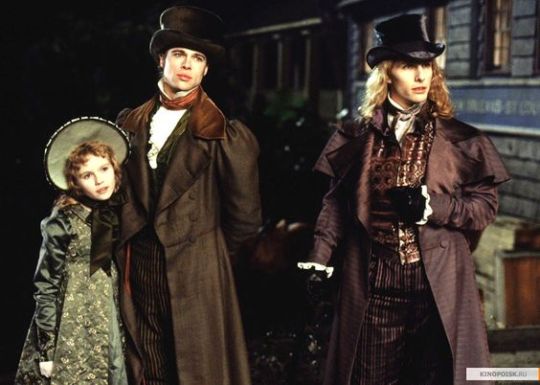
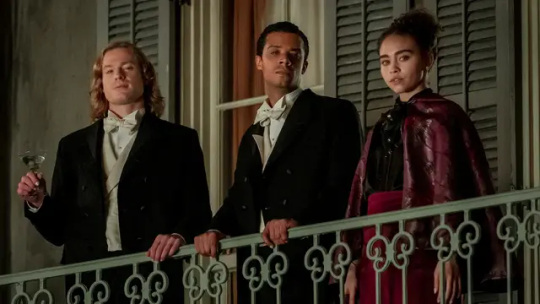
#Interview with the Vampire#amc interview with the vampire#iwtv 2022#iwtv amc#Interview with the vampire 2022#Interview with the vampire tv show#Interview with the vampire 1994#iwtv 1994#interview with the vampire movie 1994#Interview with the Vampire 1976 book#Interview with the Vampire book#the vampire chronicles#Anne Rice#louis de pointe du lac#lestat de lioncourt#claudia iwtv#the vampire armand#daniel molloy#sam reid#jacob anderson#bailey bass#tom cruise#brad pitt#kirsten dunst#christian slater#neil jordan#loustat#race theory#queer theory#vampirism
51 notes
·
View notes
Text
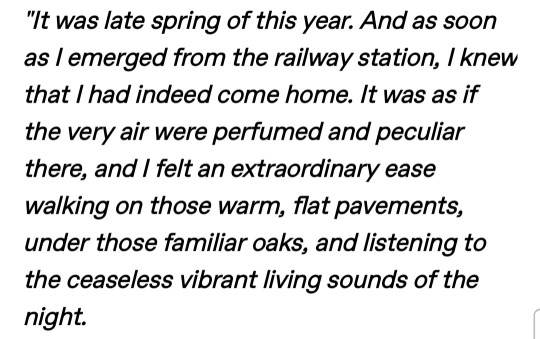
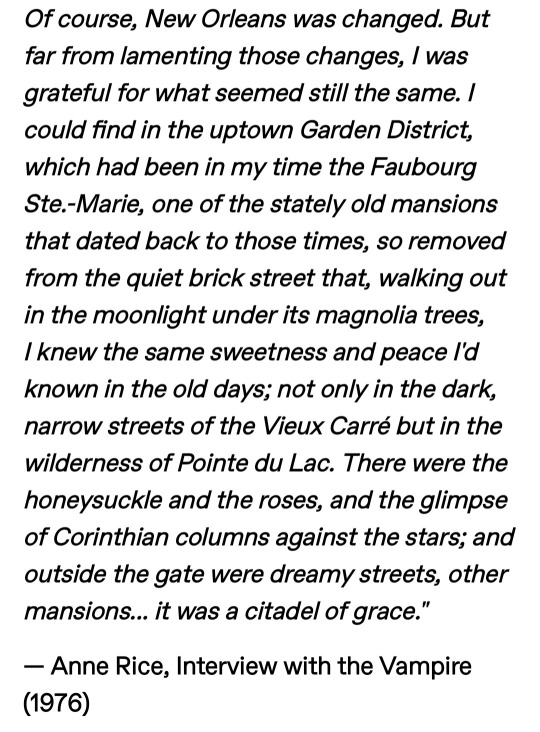
2 notes
·
View notes
Text
okay im gonna im gonna ramble for a minute about interview with the vampire so yeah spoilers ahead
so im reading interview with rhe vampire bt anne rice and the biggest critique that i hear (and that i actually Usually agree with) is that she rambles on for far too long about minute or unimportant details.
as i get closer to the end of the book (~100 pages left) i actually. i rescind this claim i made. the reason for this is that yes, oftentimes louis is prattling on about the beauty of france or the details of new orleans architecture but i find it. good? i like the scene setting and the descriptiveness to which louis (anne rice lol) describes his surroundings bc!!! bc i think it IS important!!! i think its vital for him to highlight the "first" few years of vampirehood to him and the differences between his human years and the struggle of conflict within him as to his place in the human morale system hes grown so accustomed to
i like seeing him compare his love of humanity and his desire to feast while also thinking of all the vampires that he comes across that treat him like "other" for having these thoughts and ideas and i ESPECIALLY enjoy seeing him ao clearly explain experiences that seem unexplainable like meeting other vampires in europe for the first time and describing it as haphazardly as he remembers experiencing it like!!!! hes grown so complicated and yet so simple over the years and the ways he talks of his younger vampiric self and the mindset and struggles he experienced is so intriguing to me!!!
how otherWORDLDLY!! like anne rice has her issues but this is some good fucking writing to me like im not even saying i enjoy any singular character to label any one as a "fav" (i lied its claudia u deserve better my dear this shouldnt have happened to u) i just think theyre so three-dimensional and detailed in ways some ppl to forget to make their characters detailed and im!!! eating this shit up ikay ill hush
#gata#im fucking exhausted but im also OBSESSED with rhis book rn#its so intriguing#someone recommended me servant of the bones#maybe ill add that to the list i think ill just need to check it first#what if it has gore :(#tho even iwtv cometimes makes me uncomfy but it doesnt mean i Stop#im overcoming it maybe ill be okay#anyways#byebye :3#interview with the vampire#interview with the vampire 1976
4 notes
·
View notes
Text
ok so.
1976. anne rice publishes interview with the vampire, a meditative novel she used as a way to understand and articulate her grief over the death of her five year old daughter. lestat is the fun antagonist (but really there isn’t a clear villain.) louis is anne’s grief projection of herself. armand is the wise but ultimately selfish second romantic interest. subtext that louis is in love with lestat, but it’s very much hidden beneath grief, as all his emotions are. this was intended to be a standalone novel.
1985. anne has thought about lestat for a decade and decides to make him the protagonist. she doesn’t like louis anymore (you could probably write a psychological essay on why.) lestat loves louis though! actually, lestat loves everyone! lestat is great in fact. and armand is fucking insane and tragic, and louis has always loved lestat and now they’re in massive massive love. and they will be forever, despite breakups and anne going back to the church and all the other crazy shit that happens for 30 years.
so they’re making a movie! except this movie is only interview with the vampire, and it isn’t really incorporating much or any of the rest of the series. lestat is his shallow antagonist self, louis is miserable, armand is old and wise. it’s the original vision of interview, without the 180 in characterization anne does. they don’t make the vampire lestat. they make queen of the damned but it sucks so oh well.
so amc is making a tv show! and they want it to be the ENTIRE SERIES. they WANT to put back in the fun loving and ultimately humanistic lestat that anne developed in the sequel onwards, the louis that deeply loves him, hopefully the armand that’s so complex and messed up. but the thing is, anne didn’t write those characters and relationships initially. she essentially retconned them, for the better. so in order to adapt ALL the books, necessary changes need to be made. lestat needs to be more layered, more lovable. louis needs to be more conflicted in the romance. there needs to be a CLEAR EXPLICIT INITIAL ROMANCE. they need to believably get to their dancing, living in a castle endgame. and the whiplash of the books just won’t translate to television.
so that’s the explanation of the change in loustat’s relationship from the book to the show. there’s reason for the other changes as well, but people have discussed that at length and no one’s discussed this so i thought i’d try and help people understand who may not know any of it.
3K notes
·
View notes
Note
i'm sorry if this is a bad question, but do you know anywhere online that i can read the vampire chronicles books for free? i don't want to ask my parents for money, i don't think they'd approve of me reading these types of books. i'm 19 but financially dependent on them for the foreseeable future so i don't wanna make them mad
hi! oh no, definitely not a bad question!
here's a link to a shared google folder that's been going around for a while with The Vampire Chronicles books 1-11, plus some other stuff like 'Interlude with the Undead' aka Armand's Playboy Story and 'Vittorio' (a standalone vampire novel that doesn't really have anything to do with the rest of TVC)
and here's a folder I just made that contains the PL-trilogy (so the last three books in the series)
they don't display by publication date in the drive, but the chronological reading order is as follows:
Interview with the Vampire (1976)
The Vampire Lestat (1985)
The Queen of the Damned (1988)
The Tale of the Body Thief (1992)
Memnoch the Devil (1995)
Pandora (1998)
The Vampire Armand (1998)
Merrick (2000)
Blood and Gold (2001)
Blackwood Farm (2002)
Blood Canticle (2003)
Prince Lestat (2014)
Prince Lestat and the Realms of Atlantis (2016)
Blood Communion: A Tale of Prince Lestat (2018)
a little bonus for the DM fans: I extracted the Devil's Minion's chapter from QotD a while ago to make your life and mine that much easier
enjoy, and welcome to our fandom if you decide to stick around! ♥️
#i get it i'm 28 and the price of books still makes me want to SOB and not everyone has access to a used bookstore but even then#you ask and hekate answers#vc#the vampire chronicles#lestat de lioncourt#louis de pointe du lac#armand#marius de romanus#daniel molloy#devil's minion#pdfs
457 notes
·
View notes
Text


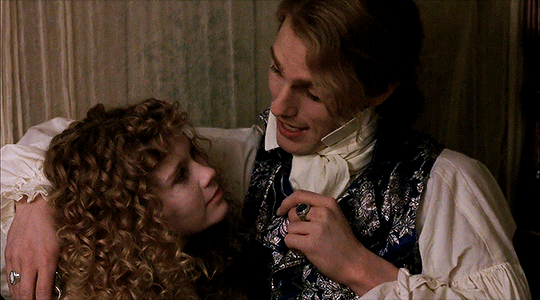

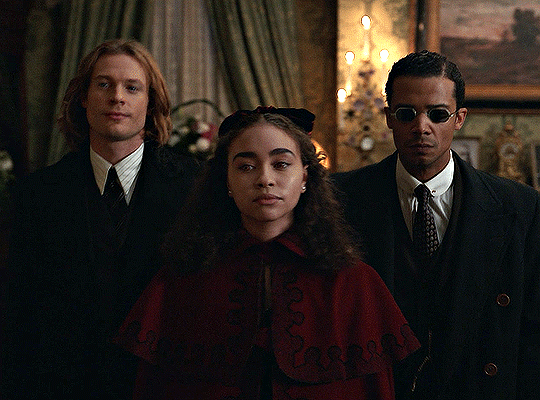
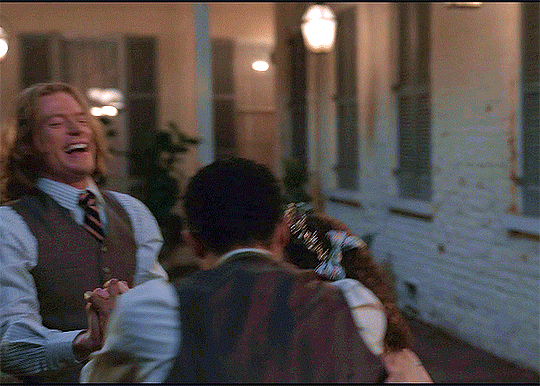
#interview with the vampire#iwtv#amc iwtv#read a book#film#polls#lgbt characters#lgbtq characters#poll#fandom polls#fandom poll#tv polls#tv poll#book poll#book polls#movie polls#movie poll#poll question#tumblr polls#tumblr poll#chaotic vampire family#lestat de lioncourt#louis de pointe du lac#louis x lestat#otp#ish#vampires#i wanna be a vampire#q&a#anne rice
34 notes
·
View notes
Text
Interview with the Vampire (book, 1976) ran so Interview with the Vampire (movie, 1994, starring Brad Pitt as Louis de Pointe du Lac, Tom Cruise as Lestat de Lioncourt, and Kirsten Dunst as Claudia) could walk so Interview with the Vampire (television series, 2022, starring Jacob Anderson as Louis de Pointe du Lac, Sam Reid as Lestat de Lioncourt, and Bailey Bass as Claudia) could RUN AT A VAMPIRIC SPEED
#now i love them all but the show man... it's some good shit#i am also realizing i left out Armand i am very sorry#interview with the vampire#interview with the vampire (1994)#interview with the vampire (2022)#the vampire chronicles#louis de pointe du lac#lestat de lioncourt#the vampire claudia#jacob anderson#sam reid#bailey bass#brad pitt#tom cruise#kirsten dunst
50 notes
·
View notes
Text
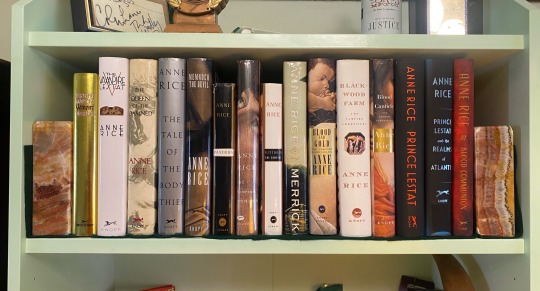
Finally completed my collection of Vampire Chronicles A. Knopf hardbacks! I’m not even halfway through reading them but I knew after buying TVL that I wanted the whole set. Even if they’re not all true first editions, I think they’re by far the most beautiful versions of these books and they’re a joy to read. I’ve also included a photo of the gorgeous crochet Lestat book jacket my partner made me which will protect these books as I continue to read them!
The breakdown:
- Interview with the Vampire 1976, 40th Anniversary Edition, 36th printing.
- The Vampire Lestat 1985, 39th printing.
- Queen of the Damned 1988, First Edition.
- Tale of the Body Thief 1992, First Edition.
- Memnoch the Devil 1995, 9th printing.
- Pandora 1998, third printing.
- The Vampire Armand 1998, First Trade Edition, signed by Anne Rice.
- Vittorio the Vampire 1999, First Trade Edition.
- Merrick 2000, First Trade Edition
- Blood and Gold 2001, First Edition
- Blackwood Farm 2002, First Edition
- Blood Canticle 2003, 2nd printing.
- Prince Lestat 2014, First Edition
- Prince Lestat and the Realms of Atlantis 2016, First Edition
- Blood Communion: A Tale of Prince Lestat 2018, 2nd printing.

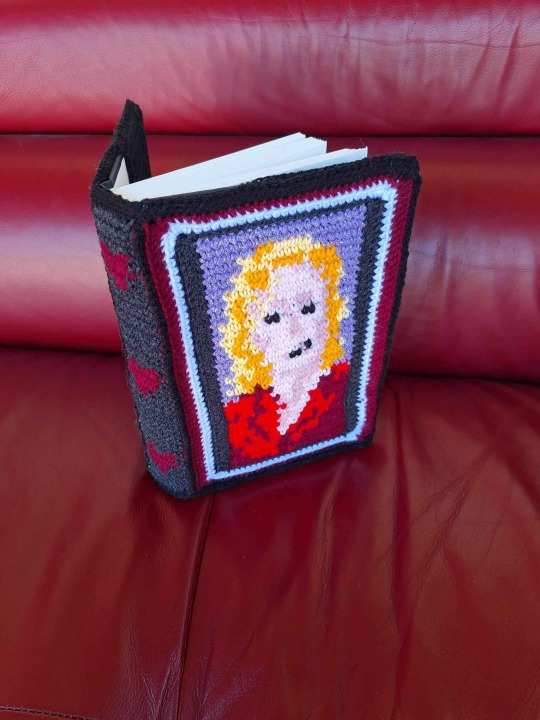
#interview with the vampire#amc interview with the vampire#anne rice#lestat de lioncourt#iwtv#sam reid#the vampire chronicles#the vampire lestat#bookblr#collection#literature
26 notes
·
View notes
Text
This is the story of Louis, as told in his own words, of his journey through mortal and immortal life. Louis recounts how he became a vampire at the hands of the radiant and sinister Lestat and how he became indoctrinated, unwillingly, into the vampire way of life. His story ebbs and flows through the streets of New Orleans, defining crucial moments such as his discovery of the exquisite lost young child Claudia, wanting not to hurt but to comfort her with the last breaths of humanity he has inside. Yet, he makes Claudia a vampire, trapping her womanly passion, will, and intelligence inside the body of a small child.
Originally begun as a short story, the book took off as Anne wrote it, spinning the tragic and triumphant life experiences of a soul. As well as the struggles of its characters, Interview captures the political and social changes of two continents. The novel also introduces Lestat, Anne's most enduring character, a heady mixture of attraction and revulsion. The book, full of lush description, centers on the themes of immortality, change, loss, sexuality, and power.
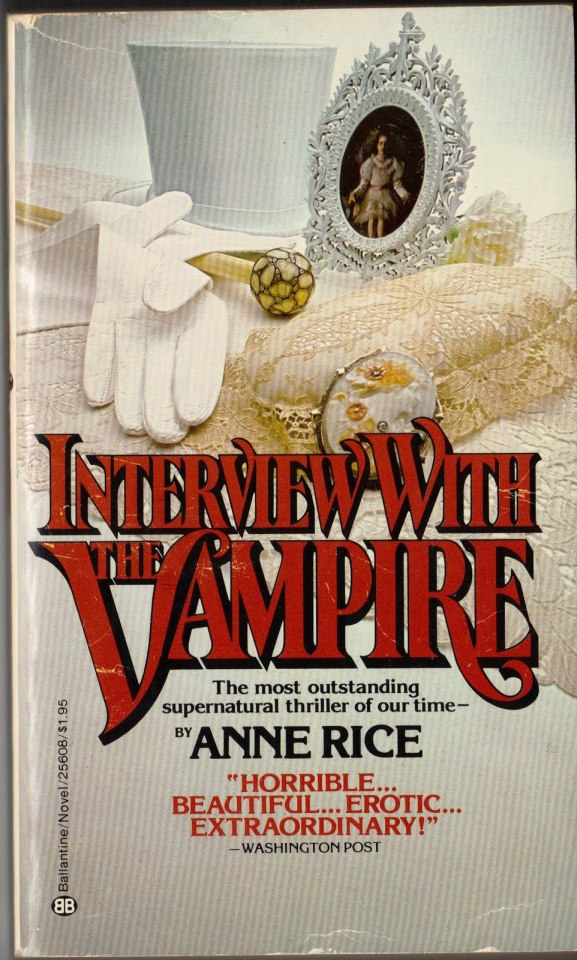
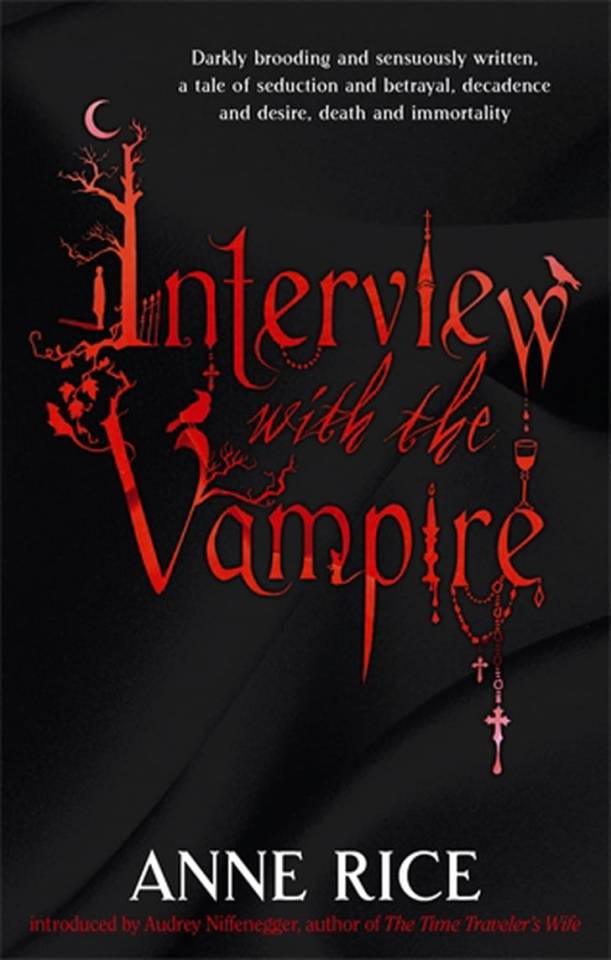
#polls#book: interview with the vampire#author: anne rice#genre: horror#genre: fantasy#genre: gothic#year: 1970s
24 notes
·
View notes
Text
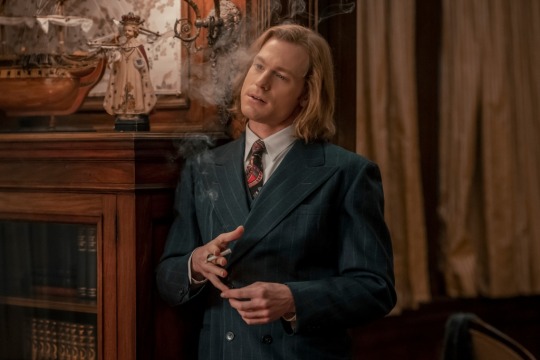
Indiewire - The 28 Best Film and TV Performances of 2022
Sam Reid, “Anne Rice’s Interview With the Vampire”
"Playing a character like Anne Rice’s Lestat is a complex task. Not only are there legions of fans who expect a certain caliber of terror and romanticism, but Tom Cruise’s performance in the 1994 film is still a hot-button topic. But Reid took on the role with all the force, charm, and horror that Rice dished out in her 1976 book. Audiences first meet him alongside series lead Louis (Jacob Anderson); He’s magnetic, charming, and oozing enough sexual allure to draw in nearly all of New Orleans. But the relationship between Lestat and Louis is described as a “fucked-up Gothic romance” by journalist Daniel Malloy (Eric Bogosian) for a reason, and it’s soon apparent that Lestat’s vampirism isn’t his only problem. Every minute of Reid’s performance here is a master class in manipulation. And when things go bad, and Louis wants to leave, Reid lashes out with fire and anger, but there’s an undercurrent of glee. He wants the audience to know Lestat thrives on emotional violence as much as anyone. It’s a performance I love rewatching, even though I know I shouldn’t."
#interview with the vampire#sam making those best of year lists as he fucking should!!!#see when you're an it girl!!!#sam reid#amc iwtv#lestat
181 notes
·
View notes
Note
Do you have any non-manga book recs? I would like to read more too, any genre
Sure! Here are 30 books I enjoyed reading sometime within the past decade or so, in order of date originally published:
BOOKS TO READ (or not, 's entirely up to you):
Pride and Prejudice (1813) Jane Austen
Wuthering Heights (1847) Emily Bronte
Crime and Punishment (1866) Fyodor Dostoevsky
The Time Machine (1895) H.G. Wells
The Metamorphosis (1915) Franz Kafka
The Hobbit (1937) J.R.R. Tolkien
Rebecca (1938) Daphne Du Maurier
Confessions of a Mask (1949) Yukio Mishima
Nineteen Eighty-Four (1949) George Orwell
Lord of the Flies (1954) William Golding
The Talented Mr. Ripley (1955) Patricia Highsmith
Rabbit, Run (1960) John Updike
We Have Always Lived in the Castle (1962) Shirley Jackson
In Cold Blood (1966) Truman Capote
Interview with the Vampire (1976) Anne Rice
The Mosquito Coast (1981) Paul Theroux
Perfume: The Story of a Murderer (1985) Patrick Suskind
Misery (1987) Stephen King
The Silence of the Lambs (1988) Thomas Harris
The Midwife's Apprentice (1991) Karen Cushman
Middlesex (2002) Jeffrey Eugenides
Oryx and Crake (2003) Margaret Atwood
The Road (2006) Cormac McCarthy
Heart-Shaped Box (2007) Joe Hill
The Hunger Games (2008) Suzanne Collins
Gone Girl (2012) Gillian Flynn
Annihilation (2014) Jeff VanderMeer
The Fisherman (2016) John Langan
The Marrow Thieves (2017) Cherie Dimaline
Paradise Rot (2018) Jenny Hval
20 notes
·
View notes
Text
The people I've seen who're upset that Louis was made a pimp in the Interview With The Vampire TV adaption because they feel it is terribly out of character for our dear, brooding, gentleman vampire are sending me into orbit thanks to the propulsive force of my rolling eyes.


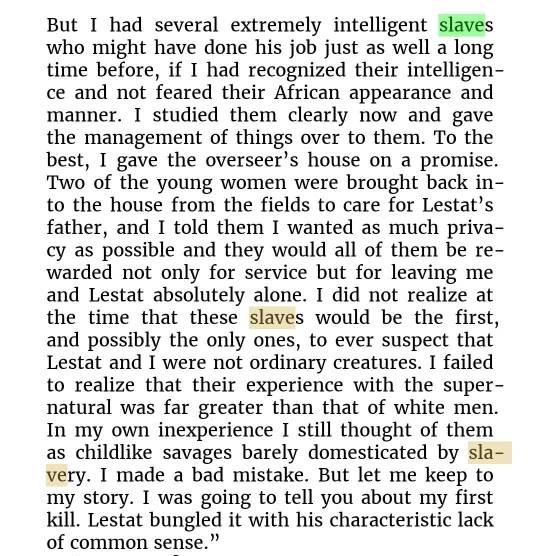
BOOK LOUIS OWNED HUMAN BEINGS AND FORCED THEM TO WORK ON HIS INDIGO PLANTATION, GIRLIES, C'MON
Him being a brothel owner/manager is a change, yes, but the writers are clearly exchanging his canonical participation in one disgusting system of human exploitation (slavery) for another (prostitution).
Some people have likely forgotten things as the book originally came out in 1976 and they may have last read it anywhere from a year to forty seven years ago, and his slave owning ends fairly quickly into the first book, but the point still stands.
#to be clear we love and support sex workers in this house (support decriminalization)#and that includes acknowledging survival sex workers who only got into it because they had no other options#I'm just tired of seeing people express the shallowest reasons for dismissing the show#it's valid not to like it but IMO its phenomenal#nearly every change they made big and small were good decisions#interview with the vampire#iwtv#amc iwtv#amc interview with the vampire#louis de pointe du lac#louis iwtv#the vampire chronicles#anne rice
36 notes
·
View notes
Text
This is a blog created to keep track of my experience reading The Queen of the Damned, but I wanted to write about some of my thoughts on the first two books of the Vampire Chronicles. So here's some stuff I wanna share about Interview With The Vampire!!
(Spoilers ahead)
Interview With The Vampire (1976)
I just know if I had read this book in high school I would have been so annoying lol.
The show is definitely my favorite version of IWTV, especially when it comes to Louis' character. Book Louis is hard to sympathize with, him being a slaveowner and all. I was aware of that before going in, but it was hard to read how matter-of-factly Louis talks about running a plantation, even in the present day. For all of Louis' philosophizing about the evil of drinking human blood as a vampire, he has nothing to say of the evil he committed as a mortal man. So glad the show changed that! And not only that, they made Louis a Black, gay man and added so, so much depth to his character and his story without taking away any of what makes Louis Louis. Anyway, I was expecting to not like book Louis as much because I was aware of all that going in.
What I was not prepared for, however, was the exact nature of the relationship between Louis and Claudia in the later half of the book. How did no one warn me about the incest hello?? Again, love that the show changed it to Claudia being more of a sister to both Louis and Lestat as she matures because, sure, Claudia is a grown woman in age/mind but she is and will unfortunately always be 5 years old in body and Louis that is your daughter.
Other than all that (which is a lot), I liked it. I was worried I wouldn't because of how much I already knew of the plot (from the show, the movie, and lurking on twitter lol), but I was hooked! The writing is gorgeous and evocative (loved seeing all the lines they included in the show). The scene where Louis and Claudia find a revenant? I was shaking! So scary.
Loved the Paris scenes with the Théâtre des Vampires. Loved the scene where Claudia's begging for Louis to turn Madeleine.
"Your evil is that you cannot be evil, and I must suffer for it."
Fire. She says it in the movie, and I'm sure they'll put it in the show too!
Armand is everything.
"I want you. I want you more than anything in the world."
??? I'm in love. And so is Louis!
"Who else, knowing us as we know each other, could do anything but destroy us? Yet we can love each other."
I just know they're going to use that line in season 2. Which brings me back to the show. I adore the show, obviously, but after reading the book I appreciate it even more for how it chose to adapt it, what it chose to keep vs change/leave out.
Some other things I liked:
Lestat not being able to kill his own father. Very human of him, loved reading that whole bit.
Any time Louis talks about Armand. I liked this line especially:
"Knowledge would never be withheld by Armand, I knew it. It would pass through him as through a pane of glass so that I might bask in it and absorb it and grow."
So warm. Makes me even more excited to see their relationship in season 2.
That's all I can think of. I wish I had documented my thoughts as I was reading the book, but oh well. (Also RIP Claudia, light of my life, I am not ready to see her go).
I will post about what I thought of The Vampire Lestat next, and then get into posting about The Queen of the Damned!
#interview with the vampire#iwtv#louis de pointe du lac#vampire chronicles#claudia iwtv#queen of the damned#tw incest
8 notes
·
View notes
Text
Anne Rice, Gay Vampires and the Mistreatment of Claudia in Interview with the Vampire
This was my senior thesis so enjoy.
Intro
Anne Rice’s debut novel Interview with the Vampire (1976) was not well received at the time of its publishing. One reviewer for the New York Times, Leo Braudy, even went so far as to say “there is no story here, only a series of sometimes effective but always essentially static tableaus out of Roger Corman films, and some self‐conscious soliloquizing out of Spiderman comics, all wrapped in a ballooning, pompous language” (Braudy 1976). However, it is now widely considered to be one of the best-selling novels of all time, having been made into a film 12 years after its release and maintaining enough popularity to be turned into a television series in 2022, some 46 years later. While not well received by critics, audiences loved it then and still love it now. Interview is the first novel to allow the vampire to tell their own story; along with the erotic overtones of the novel is what captured the attention of audiences around the world and what kept their attention. Currently, on GoodReads.com the novel has an overall 4.01-star rating with one reviewer writing “Dark and enthralling. This book asks readers to reflect on the constitutions of love and loneliness” while another comments on the writing style, “Anne Rice really makes you feel the depth of emotion that The Vampire goes through.” Both reviews are from 2023. Not only is Interview still relevant because of its content but the impact it’s had on the vampire genre as a whole. It’s opened the door to allowing vampires to not only tell their own stories but to allow them to feel deeply.
Throughout the novel, there is a heavy overtone of erotic desire, often homoerotic desire, mostly between the main character Louis and his vampire father/husband Lestat but also with his later lover Armand. There are also instances of erotic desire with other characters as well; desire is often associated with the act of feeding. Many see the overall desire within the book as being gay, which is one of the reasons its popularity has persisted. While Anne Rice would later write openly gay vampires, this was not the time for that; instead, we are given subtle hints and overtones. After a conversation with Rice, Katherine Ramsland her biographer would write that “The new vampire is brought over into a dramatically changed existence with a gender-free perspective” (Ramsland 148), which confirms the homoerotic overtones within the book. Rice also claims to have attempted to write her vampires as androgynous and without male or female distinctions or as Ramsland said ‘gender-free’. The reality is that Rice has placed Louis and Lestat in traditional gender roles as parents while also feminizing their vampire daughter/lover Claudia. Claudia is also read as feminist through the way she is treated by those around her, in particular their failure to fully acknowledge her as a woman, not a child.
What the people say past and present
Vampires have always been seen as metaphors for various things from the hidden sexuality or desires of the author to a critique of society's values. As William Hughes, a Professor at the University of Macau, put it in his contribution to the book A Companion to American Gothic (2013), “The vampire, an enduring consensus suggests, is the perfect vehicle with which to express the myriad and conflicting cultural implications of human sexual activity and identity” (Hughes 340); vampire lit makes for a good space to explore sexual activity and identity. This idea can be further narrowed but adding gender into the equation. As Melissa Ames says in her chapter of the book Bitten by Twilight (2010), “The fact that the same gender critiques appear in both Dracula and in more contemporary texts suggests that the vampire narrative is a productive space to tease out problems of gender and sexuality, but that it is not a space that necessarily resolves such issues since they recycle decade after decade and text after text in similar fictional constructs”(Ames 44-45); seeing gender critiques within vampire literature has always been common and will continue to be. This idea was echoed in 2016 in the book Women and the Gothic, specifically by contributor Gina Wisker who points out that “female vampires destabilise such comfortable, culturally inflected investments and complacencies and reveal them as aspects of constructed gender identity resulting from social and cultural hierarchies” (Wisker 150), taking the idea of vampire literature critiquing gender a step further by focusing on the role of the female vampire.
Interview with the Vampire has been no exception to analysis or critiques of the portrayal of gender and sexuality within vampire literature. Many cite how Rice shows gender roles in the relationship between Louis and Lestat but most importantly they turn to Claudia and her mistreatment. Many see the way she is treated by those around her, including her vampire fathers, as placing her in a traditional female gender role, often through their lack of acknowledging that she is a woman trapped in a child’s body. Nina Auerbach notes in her book Our Vampires, Ourselves (1996) that Rice’s vampires are compulsive storytellers but Claudia never gets to tell her own story; only men tell her story (Auerbach 154-55). This is a starting point for the way many read Claudia as being placed in a gender role. Auerbach also points out how “Claudia is an adult male construction, a stunted woman who has no identity apart from the obsessions of the fatherly lovers who made her” (Auerbach 158), something that in 2013 Hughes similarly pointed out stating that “Louis’s narration, and his coda,[he] silently deflects the agency from her to him.” (Hughes 345). Claudia is placed in a gender role has persisted through time. The relationship between Louis and Lestat is no exception to a critique or analysis of gender within the novel. Most notably their gender roles are seen in the way they parent Claudia, but these roles can also be seen within their relationship and the way Rice has characterised them. Ken Gelder points out in his book Reading the Vampire (1994), stating that “Rice emphasises the differences between these two male vampires, with Louis as delicate and sensitive (i.e. feminised) and Lestat as aggressive and impetuous (i.e. masculinised)” (Gelder 112). Rice shows gender roles throughout the relationship between Louis and Lestat often feminising one and masculinising the other.
Pre-child Love
In order to establish a foundation of gender roles within the novel you must first look at the relationship between Louis and Lestat before they created/birthed Claudia. In particular, you must look at how their relationship can be seen as queer or as having homoerotic overtones. Iulia Pintilie¹ points out in her article for the Journal of Romanian Literary Studies that “a passionate tension between the male vampires is clearly suggested in the writing” (Pintilie 642), something that can be seen throughout the novel but most notably early in their relationship. When we first meet Lestat in the novel it is at Louis’s bedside where he thinks him a possible doctor or angel. We, like Louis, quickly learn that Lestat is not normal or human, he is some kind of creature. One that wants Louis to be like him so that he may take control of Louis's plantation (16).
Louis gives their relationship a homoerotic overtone when he, in response to being asked to describe his turning, tells the reporter “I can’t tell you exactly, any more than I could tell you exactly what is the experience of sex if you have never had it” (15); comparing the loss of virginity to his turning implying a sexual overtone. Their relationship and the turning itself are given further erotic overtones when Louis says “I remember that the movement of his lips raised the hair all over my body, sent a shock of sensation through my body that was not unlike the pleasure of passion” (19); again equating sex and being turned. After his turning Louis spends time staring at things like the buttons on Lestats coat or the trees and cobblestones, here Lestat breaks the erotic tone created in the turning scene. Lestats sends Louis to relieve his body of waste and upon Louis's return, he finds him already working on the plantation papers–cementing the idea that Lestat only wants him for his money. This is an aspect of their relationship that Pintilie describes as resembling “an eighteen-century aristocratic union in which the two husbands increase their family fortunes through their marriage” (Pintilie 647), though at this moment it's not yet a marriage.
In the five years that make up their relationship–some sixty pages of the novel–before Claudia’s birth/turning, Louis struggles to come to terms with what Lestat has made him. Louis often refers to how violent and unfeeling Lesast could be, noting early in their relationship how Lestat could go from one emotion to the opposite. Louis notes in Lestat's treatment of his father that “he’d been gracious to the old man, almost to the point of sickening, but now he became a bully” (23); Lestat goes quickly from one emotion to another. Louis also notes how easily Lestat is set off when he says that in response to Louis wishing to sleep alone, “he became furious” (34) before Lestat sets off in a small tirade over why they should be bunking together. Lestat’s repeated instances of enjoying violence or being unfeeling are what give him his masculised gender role whereas Louis is often repulsed by violence and feels deeply thus femisising him. Louis even notes Lestats lack of emotions when after describing his own deep feelings about being a vampire he tells the reporter “Lestat felt the opposite. Or he felt nothing” (31). Driving home the idea that Lestat is different from Louis.
In the five years prior to Claudia joining them, Louis experiences many things with Lestat from his own turning to learning to kill but never embracing it to his home being burned to the ground. Throughout it all Lestat remains a violent, emotionally unpredictable manipulator in Louis’s life, not unlike one would see in an abusive intimate partner. Louis even tells the reporter that “I had to stay with him” (35), going on to explain that Lestat was keeping information from him about his vampire existence as a way to force him into staying. Something Lestat continues to do even after turning Claudia. Eventually, towards the end of their five years, Louis finally decides he must leave Lestat when they flee to New Orleans city proper after an incident at the Freniere plantation. Louis tells the reporter “I have to leave him or die” (71), this decision comes only hours before he meets Claudia for the first time and days before they would turn her.
Post-child Love
When Rice chooses to have Louis and Lestat become fathers, she also makes them husbands cementing their “marriage” when they turn Claudia. While Lestat is the one to complete Claudia’s turning by feeding her his blood, Louis participates by having been the one to drain her thus making them both her vampire fathers. Louis is at first a reluctant ‘mother.’ He did not want to turn Claudia but Lestat forces him into it, using her as a way to trap Louis into staying with him. Candace Benefiel explains this scene best telling readers in her article for the Journal of Popular Culture² that “The whole scene reads like a couple having a child in an attempt to make a failing relationship once more viable” (Benefiel 267). In this case, it’s Lestat attempting to keep the relationship viable, he explains to Claudia after her turning that “ ‘Louis was going to leave us,’ (...) ‘He was going to go away. But now he’s not. Because he wants to stay and take care of you and make you happy.’ (...) ‘You’re not going, are you, Louis?’ ” (94). At this moment he is also revealing the truth of her turning to Louis as well. This plan of Lestat’s works, Louis tells the reporter that “Afraid of fleeing alone, I would not conceive of risking it with Claudia. She was a child. She needed care” (97), cementing his need to stay with the ‘family.’ As if Louis was a mother staying with an abuser to protect a child.
In making them parents Rice masculinizes Lestat–he is only ever the ‘father’ and feminizes Louis–he is called ‘father’ but acts as a ‘mother.’ Lestat takes on a more traditional masculine father role when Louis tells us that he “was loving to her, proud of her beauty, anxious to teach her that we must kill to live and that we ourselves could not die” (97). He is excited to teach her to kill, to be aggressive–traits that can be seen as more masculine. Louis takes on a more feminine or motherly role in that he is the one to educate her on things like “mortal creations”, poetry, music, and books (100), teaching her softer life skills that are seen as more feminine. While Louis’s dedication and attachment to Claudia can be viewed as ‘motherly instinct,’ you could also argue that it is simply parental the way he wants to protect her and keep her close throughout the novel, though it’s the juxtaposition of Lestat's masculine traits that give Louis’s a more ‘motherly’ feel. Louis even tells the reporter “At first, I thought only of protecting her from Lestat. I gathered her into my coffin every morning and would not let her out of my sight with him if possible. This was what Lestat wanted, and he gave little suggestions that he might do her harm” (97), implying Louis is a ‘mother’ protecting their child from an abusive ‘father’–Lestat. The three spend some sixty-five years living together as a family before tensions arise. Before their family comes apart, Louis continues to try to keep himself isolated from Lestat, now having Claudia join him when she is not off-killing with Lestat. Louis explains to the reporter that “there was no quarreling. We kept to ourselves (...) Claudia and I pursued our natural tastes and Lestat went about his lavish acquisitions” (104).
When tensions between Claudia and Lestat begin to rise so do tensions with Louis and Lestat. Lestat is frustrated with Claudia ignoring him or as Louis tells the reporter “she grew cold to Lestat” (105). This leads to Lestat lashing out at Louis after Louis attempts to stop him from lashing out at Claudia and later to another argument. An argument where Louis cements seeing himself as Claudia’s mother telling the reporter “ ‘What’s the matter with her!’ he [Lestat] flared at me, as though I’d given birth to her and must know” (105). It’s in the issues or tensions that we can once again see the relationship between Louis and Lestat as abusive. Particularly with Louis as the victim and Lestat as the abuser; this is one of the main ways that Rice has applied gender roles to their relationship. She makes the relationship reminiscent of a heterosexual one by making Louis the ‘mother’ figure to Claudia. This is shown subtly when after Claudia tells Louis they must leave Lestat they begin to plan their escape (118-119). Louis explains to the reporter that before now he’d “grown accustomed to him, as if he were a condition of life itself” (118). Louis had grown complacent in the relationship content to keep himself and Claudia from Lestat but never leaving. Louis goes on to explain that while he planned to buy their freedom (119) he “did not believe it would be possible to escape him [Lestat]” (119); reminiscent of the emotions a victim planning their own escape may feel.
Louis’s ‘motherly’ instinct is seen again towards the end of the novel when the Theater Des Vampires come to collect Louis, Claudia, and Madeliene for trial. Louis tells the reporter that “the instinct to protect Madeleine and Claudia was overpowering” (294), he also attempts to bargain with Lestat for her life saying to him “ ‘You let her go, you free her…and I will…I’ll return to you’ ”(296). In both of these cases, Louis is attempting to protect Claudia the way a mother or parent would. In the second instance, Louis even attempts to stand up to Lestat as a means to protect Claudia or at the very least justify her actions against him by telling the others “how you treated us, that we didn’t know the laws, that she didn’t know of other vampires’ (296); he is attempting to get Lestat to own to his part in Claudia’s attempting to kill him, to admit to abusing his power over them.
Claudia as treated by her ‘fathers’
It’s not until Claudia has lived with Louis and Lestat for over sixty-five years that Loius begins to acknowledge that she is in fact not a child but a woman trapped in the body of a child remarking to Lestat that “She’s not a child any longer,[...] I don’t know what it is she’s a woman” (105). Louis only begins to realize this after she has been ignoring Lestat, resenting him for being her “father.” Both men realize that she is grown again only after she begins to question her origins and subsequently wants to leave Lestat to free them from him saying to Louis “And we’ve been his puppets, you and I; [...]. Now’s time to end it, Louis. Now’s time to leave him”(118). Claudia tells Louis that she will kill Lestat to free them of him. Not because she believes it’s the only way to free them but because she wants to, she repeatedly tells Louis “ ‘I can kill him. (...) I want to kill him. I will enjoy it!’ ” and “ ‘I want him dead and will have him dead. I shall enjoy it’ ” (124). They proceed to argue over if Lestat even can be killed and after she comments she may inherit Lestats power after killing him, Louis becomes angry. He tells the reporter “ ‘I was enraged now. I rose suddenly and turned away from her’ ” (124) but he quickly reverts back to seeing her as childlike in her innocence, seeing her wanting to be free of Lestat like a child throwing a tantrum and making idle threats. It's not until she attempts to kill Lestat that he again sees her as a woman though it is at the expense of also being repulsed by her. After Claudia kills Lestat, Louis tells the reporter “I turned away from her. I was unable to look at her (...) I would not look at her (...) I couldn’t stand the sight of her” (139-140). Though once Claudia shows distress at Louis's reaction he reverts back to treating her like a child rocking her as she cries in his arms.
Lestat never sees Claudia as a woman or an adult; to him, she is simply a means to keep Louis with him, and as a toy or as Lestat calls her a “doll” for him and Louis to play with. Lorna Jowett points this out in her article “ ‘Mute and Beautiful’: The Representation of the female vampire in Anne Rice’s Interview with the Vampire”, telling readers that “In neither case is Claudia of importance for herself; rather she is simply an object to be used in the struggle/relationship between two male vampires” (Jowett 56). Lestat eventually comes to see Claudia as a child, his and Louis, but by the end of the novel he sees her as the enemy and never does he view her as a woman.
Throughout the novel both Louis and Lesta refer to Claudia as a doll; Louis often refers to her by material things as well. After first presenting the idea of turning Claudia Lestat even tells Louis to “think of all the pretty dresses we could buy for her” (75). Louis even goes as far as explaining that after her turning Lestat hired dress and shoemakers to outfit Claudia; that he “played with her as if she were a magnificent doll, and I played with her as if she were a magnificent doll (99). Both men also treat her like a doll up until she begins to ask questions often dressing her and doing her hair. Katherine Ramsland notes in the book The Vampire Companion⁴ that “Lestat and Louis treat Claudia like a doll, despite the fact that her mind matures into that of an intelligent, assertive, and seductive woman” (Ramsland 69); even after her maturing they continue to treat her as a doll. Louis further feminizes Claudia by placing emphasis on more material items like her clothes and hair. Gabriella Jonsson says this well when in her article for the Journal of the Fantastic in the Arts³ she claims “Claudia’s “feminity” is expressed only through clothes and hair, making her gender identity fluid, easily disruptible” (42). Louis often refers to Claudia's dresses, hair ribbons, or even her blonde hair as a way to not only give her physical description but to emphasize her femininity and adolescence. As we know from Louis she is often dressed in colorful puffed sleeves, hair ribbons, and slippers like you might see a doll wearing. Even in her death, Claudia is defined by material things, Louis knows she is dead after seeing not only Lestat holding her yellow dress and her golden hair.
Claudia as perceived by others
Other vampires aside from Louis and Lestat tend to overlook Claudia, something Louis notes when telling the story of his and Caludia’s first night with the Theater Vampires, stating to the interviewer “Knowing what I also knew and what they [the female vampires] seemed unable to grasp: that a woman’s mind as sharp and distinct as their own lived within that small body” (243).The other female vampires Estelle and Celeste– the only two to get named– take an interest in Claudia’s beauty, having her flaunt her looks the first night they meet. Though they quickly reveal their true feelings towards Claudia, Estelle tells her in front of the other vampires that “black was the color for a vampire’s clothes, that Claudia’s lovely pastel dress was beautiful but tasteless” (244) causing everyone to laugh at her. Louis also notes that Celeste appears to not like Claudia early on when in response to a question she asks he claims “her [Celeste’s] eyes reflected a certain contained hostility” (244) only further cementing the notion that these two vampires do not like Claudia. The other vampires like Santiago see her as neither child nor vampire. To them, she is simply a toy, something they can play with to soothe their boredom and allows them to indulge in their cruel nature. They do not see her as an equal which could be because she appears as a child but they feel the same lack of intellectual interest in Louis, who is only saved from being their target by Armand's interest in him. Armand overlooks her simply because he has no interest; he is more concerned with getting Louis to leave Paris with him, to become his companion. Ultimately Armand has no personal feelings about Claudia only seeing her as an obstacle to getting Louis, something Claudia is aware of. She tells Louis after their first meeting with him, “Do you know what he said….that I should die'' (249), explaining to Louis after that “He would have you, and he would not have me stand in the way” (250). Armand notes to Louis that it was cruel of them to turn Claudia seeing as she will never be a full woman, that is a woman who has reached physical maturity, telling Louis that if he were in a position that required him to turn his human child-blood-slave he would not, “because he is too young, his limbs not strong enough, his mortal cup barely tasted”(252). It would be a disservice to turn him, a “flaw” as he calls it. He notes the problem with turning a child, the disservice that her creators did in making her, saying to Louis “And then there is this mysterious child: a child who can never grow, never be self-sufficient” (252), telling him that most other vampires wouldn’t turn anyone who could not be self-sufficient. Having this vampire child with him is part of the reason the other vampires have taken an interest in them, it's quite unusual. Also, Louis and Claudia are not unfeeling vampires (he still holds onto his humanity), making them stand out in a way that makes them easy targets for a group like the Theatre Vampires.
Alternatively, Madeleine only sees Claudia one way, as an immortal child. As we know Madeleine is grieving the loss of her own daughter so that's what she sees in Claudia. When Louis is asking Madeliene if she will care for Claudia he also asks “Is that what you believe her to be, a doll?” (267), though she responds with “ ‘A child who can’t die! That’s what she is,’ ” (267). This interaction tells us that while Madeliene may not see Claudia in the same doll-like way Louis and Lestat once do she still does not recognize her for what she is–a grown woman trapped in the body of a child. After her turning Madeliene becomes obsessed with Claudia, making her clothes and furniture that are proportionate to her size. Beyond Madeliene's grief-induced obsession with Claudia being an immortal child that she must provide for, we know nothing else of their relationship or Madeliene’s perception of her.
Claudia on her situation
Claudia is not ignorant of her position within her family and in the world, understanding that she will always appear as a child so no one will treat her as a woman, a point of great frustration and struggle for her. Before her demise in the novel, she has come to terms with her situation and has chosen a new caregiver for herself so that Louis may be free. Though she must beg him to do so. Louis only concedes after speaking with Madeliene–an adult–emphasizing that Louis does not see Claudia as an equal (adult). It's in the turning of Madeliene that we can see Claudia as other or less womanly in the eyes of men; it brings Louis great pain to turn Madeline causing him to see Claudia as absurd or monstrous. She must ask Louis to do this because while she is a vampire she can never turn another, that is create children, due to her size. Lestat points this out, stating “You don’t have the power. Either of you” (Rice 132) after Claudia makes a comment about the three of them filling the world with vampires. She must beg Louis to do it for her, once again emphasizing her child and womanly-like helplessness, telling Louis in response to his hesitance at turning Madeliene “ ‘Because I cannot do it.’ Her voice was painfully calm, all the emotion under the hard, measured tone. “I haven’t the size, I haven’t the strength! You saw to that when you made me! Do it!’ ” (260). It's in this instance, of Claudia begging Louis to turn Madeliene, that we can see her awareness and frustration with her situation. She tells Louis that had he waited “six more mortal years, seven, eight…I might have had that shape! … I might have known what it was to walk at your side.” (261-62). This is also where we can see her acceptance of her situation as she explains to Louis that he must “Give her [Madeliene] to me so she can care for me, complete the guise I must have to live! And he can have you then! I am fighting for my life!” (265). She points out how she will not survive this world alone; she must be forever tied to another. We can also see her anger in having been immortally bound to a child's body when she calls Louis a “monster” and in her killing of Lestat after discovering he was the one to turn her. This anger can be seen in how his initial “murder” is not one of passion but is intricately planned with Claudia poisoning him to make him an easier target though his later “murder” is one of self-defense seeing as Claudia is attempting to protect herself and Louis from Lestat’s attack that final night in New Orleans.
The other women
Women are not often seen–that is given speaking roles or even names– in the novel. There are a few like Babbette Freniere–a human that Loius and Lestat knew before Claudia’s creation, Celeste & Estelle–the only other female vampires noted in the novel, Madeliene the doll maker turned vampire, and of course, our main female figure Claudia the vampire child created in an attempt to save her ‘father’ relationship.
Babette takes up little space in the novel only being initially significant because of Lestat’s interest in killing her brother and Louis's concern for their family plantation. Before Louis and Lestat must flee to the Feniere plantation for aid Babette is only mentioned when Louis advises her to keep the plantation after her brother's death. Louis shows his respect for Babette not only in advising her to keep the plantation but before then when he describes her to the reporter as “not only as smart as her brother, but far wiser” (43). We see the downfall of Babette when after Louis and Lestat go to her for aid, she attacks Louis attempting to kill him because she believes him to be “from the devil” (65). The last time Babette is mentioned is when Lestat mentions that now some sixty-five years later the Freniere plantation is meant to be haunted. This causes Louis to remember Babette, he tells the reporter that she “died young, insane, (...) insisting she had seen the devil” (130); an insanity caused by discovering that Louis is not human. Babette is also used in the novel as a tool to further Louis’s self-loathing. She acts as a symbol of him holding onto his humanity and what was left of his human life. She even validates his thoughts that he is from the devil when she tells him such and calls him a “monster.” Overall we only know Babette as the human Louis saw his humanity in, a human who descends into madness.
In contrast, there are the two notable female vampires Celeste & Estelle who are often characterized as what you could call ‘mean girls.’ They are initially introduced as part of the Theater des Vampires, women who at first seem to take to Claudia fondling her and having her turn about for them (243). Louis is quick to note that Celeste's eyes “reflected a certain contained hostility” (244) and that Estelle is condescending to Claudia when she points out that “black was the color for the vampire’s clothes, that Claudia’s lovely pastel dress was beautiful but tasteless” (244) causing everyone to laugh at her. We also know from Armand that Celeste is jealous of Claudia, he notes “She is jealous of the child’s beauty” (254); another reason they can be characterized as ‘mean girls.’ Overall they can both be viewed as catty ‘mean girls’ who are jealous of Claudia and only wish to play games with both her and Louis. In the end, they are killed, in fact, no female vampire survives the novel.
Madeleine is the last woman in the novel to be named. Not only does Madeliene die by the end she is only in forty-five pages of it. While she is used only as someone to replace Louis as Claudia’s caretaker we do get to see the beginnings of her descent into madness. When we first meet Madeleine it is after Claudia has brought her home to have Louis turn her; her only significance is in replacing Louis. We quickly learn though that while Claudia intends to have her as a guardian, Madeleine only wishes to relieve the guilt of having lost her own daughter by replacing her with an immortal one; Madeleine notes this to Louis “A child who can’t die! That’s what she is” (267). Her madness starts quickly after her turning when Louis notes that she burned her dead child's belongings and that he “had to lead her away from men and women she could no longer drain dry” (273). He even outright calls her mad when talking about those few nights before her death. Louis also notes that Madeleine had become “accustomed to dreaming; and that she would not cry out for reality, rather would fee reality to her dreams, a demon elf feeding her spinning wheel with the reeds of the world so she might make her own weblike universe” (273); he gives his explanation for what was happening to Madeleine. In the end, Madeliene is only remembered by Louis not only for her madness but for her cries as the Theater Vampires took them away.
Conclusion
The claim that Anne Rice has made of writing vampires as being without male or female distinctions or as being “gender-free” (Ramsland 148) is disproved through a close reading of Interview with the Vampire. The main characters within the novel Louis, Lestat, and Claudia present to readers the gender roles which Rice claims to have not made. Through the relationship that Louis and Lestat share–both pre and post-Claudia–you can see how she has made Lestat masculine in a way that gives Louis a femininity. Through Claudia and her mistreatment Rice once again shows that she has given her vampires' gender distinctions. One can also see Rice’s gender distinctions in her treatment of women in the novel as a whole but it is most notable in Claudia. Claudia the immortal woman-child whose story is only told by a male vampire in relation to a male vampire.
End notes
¹ “GENDER CONVENTIONS: HOMOSEXUAL EROTICISM AND FAMILY LIAISONS IN ANNE RICE AND NEIL JORDAN’S INTERVIEW WITH THE VAMPIRE.”
² “Blood Relations: The Gothic Perversion of the Nuclear Family in Anne Rice's Interview with the Vampire.”
³ “The Second Vampire: ‘Filles Fatales’ in J. Sheridan Le Fanu’s ‘Carmilla’ and Anne Rice’s ‘Interview with the Vampire.’”
⁴ The Vampire Companion: The Official Guide to Anne Rice's "The Vampire Chronicles"
Works Cited
Auerbach, Nina. Our Vampires, Ourselves. University of Chicago Press, 1996.
Benefiel, Candace R. “Blood Relations: The Gothic Perversion of the Nuclear Family in Anne Rice's Interview with the Vampire.” The Journal of Popular Culture, vol. 38, no. 2, 2004, pp. 261–273.
Braudy, Leo. “Queer Monsters.” The New York Times, 2 May 1976. NYTimes.com, https://www.nytimes.com/1976/05/02/archives/queer-monsters-interview-with-the-vampire-vampire.html.
Click, Melissa A., and Melissa Ames. “Twilight Follows Tradition: Analyzing ‘Biting’ Critiques of Vampire Narratives for Their Portrayals of Gender and Sexuality.” Bitten by Twilight Youth Culture, Media, & the Vampire Franchise, Lang, New York, NY, 2010, pp. 37–53.
Gelder, Kenneth. “Vampires in the (Old) New World: Anne Rice's Vampire Chronicles.” Reading the Vampire, Routledge, London, 1994, pp. 108–123.
Interview with the Vampire (The Vampire Chronicles, #1). https://www.goodreads.com/book/show/43763.Interview_with_the_Vampire. Accessed 3 Apr. 2023.
Jönsson, Gabriella. “The Second Vampire: ‘Filles Fatales’ in J. Sheridan Le Fanu’s ‘Carmilla’ and Anne Rice’s ‘Interview with the Vampire.’” Journal of the Fantastic in the Arts, vol. 17, no. 1 (65), 2006, pp. 33–48.
Jowett, Lorna. "Mute and Beautiful": The Representation of the Female in Anne Rice's Interview with the Vampire." Femspec, vol. 4, no. 1, 2002, pp. 59
Pintilie, Iulia-Mădălina. “GENDER CONVENTIONS: HOMOSEXUAL EROTICISM AND FAMILY LIAISONS IN ANNE RICE AND NEIL JORDAN’S INTERVIEW WITH THE VAMPIRE.” Journal of Romanian Literary Studies, no. 07, 2015, pp. 642–53.
Ramsland, Katherine. Prism of the Night: A Biography of Anne Rice. Penguin, 1994.
Ramsland, Katherine. The Vampire Companion: The Official Guide to Anne Rice's "The Vampire Chronicles". Ballantine Books, 1995.
Rice, Anne. Interview with the Vampire. Ballantine Books, 1976.
Wisker, Gina. “Female Vampirism.” Women and the Gothic, edited by Avril Horner and Sue Zlosnik, Edinburgh University Press, 2016, pp. 150–66. JSTOR, https://www.jstor.org/stable/10.3366/j.ctt1bgzdfx.14.
A Companion to American Gothic, edited by Charles L. Crow, John Wiley & Sons, Incorporated, 2013. ProQuest Ebook Central, https://ebookcentral.proquest.com/lib/stedwards/detail.action?docID=1388810
#interview with the vampire#vampires#anne rice#the vampire chronicles#louis de pointe du lac#lestat de lioncourt#claudia de pointe du lac#vampire history#gay#feminism#louis and lestat#gay dads#woman-child#claudia deserved better#louis and lestat totally wanted to fuck#armand#madeline also deserved better#anne rice isn't the best#senior thesis#just graduated#I spent four months on this so please give me feedback#Really someone read this#I also have a link to a portfolio site if anyone wants it#the site has other writings on it my favorite are the short stories
35 notes
·
View notes
Text
Vampire Chronicles Basics
Okay, with the new Interview with the Vampire show coming out, there’s probably going to be some folks who might be curious about the books and wondering why there’s so much disrespect towards the author. This probably isn’t the ONLY primer, but like, whatever.
Note: I never got around to reading all of her books, and some of this is drawing from memory though wikipedia is helpful.
Contextual History Lesson Time!
As a media criticism type person, I find it important to not examine media in a vacuum, and take into account what was happening at the time it was created.
The timing of the first three books is notable. Interview with a Vampire was released in 1976, The Vampire Lestat was released in 1985, and Queen of the Damned was released in 1988.
So we have one book with gay subtext released post free love movement but prior to gay folks becoming more known in society, then two more released during the aids crisis with the queer subtext/text still going strong. This? This is huge. Reportedly, there were people sending Anne Rice letters about how amazing it was to see themselves in the characters. Some these days might roll their eyes at how subtext might be revolutionary, but please understand. During the aids crisis, the queer community, particularly gay men, were being blamed and discriminated against to horrifying levels to the point gay men still can’t give blood.
So for a book series to have not only the metaphor of penetration and being an outbut but also have these characters seem very gay? It’s huge! It’s like a weight being lifted off, even just temporairly, while you go, “Someone sees me and my situation.”
The Vampire Lestat even had Lestat’s mother questioning her gender and deciding to dress and act more masculine. Sure, these days we’d call it “problematic” trans rep for many reasons, but back in 1985? Except for certain more indie films, trans people weren’t even talked about.
Which is a huge reason the series got big among the queer community, others caught wind, and eventually that movie with Brad Pitt was made.
And now we’re in the 90s with a few things happening. One of which being Anne Rice uh...Firing her editor? Not bothering with an editor? Whatever happened, the quality of writing goes downhill.
Additionally, Anne Rice was going through...a lot, and it shows in her writing. She started as one sect of Christianity, left it after a family member died, was athiest/agnostic for awhile, then went to a different sect of Christianity when another family member died, then eventually was in her own thing of believing in God & Jesus but not following any particular sect. Then she died.
This is relevant, as we see Lestat go from prissy rockstar to literally meeting Jesus. So. There’s that.
Another thing that happened in the 90s was the internet becoming bigger, resulting in things like forums, chatgroups, livejournal, and essentially online fandom. People in the Vampire Chronicles fandom began sharing their fanfiction.
Anne Rice hated that. It was her world, her property, her Gary-Stu, and therefore only she could write Vampire Chronicles. She began suing anyone who was writing fanfiction, yes, even the broke teenagers.
She wasn’t the only one doing this of course, but she was certainly adamant about it. Additionally, there’s an emotional element too. Because her work was one of the few popular media where queers could see themselves in, it was like a betrayal to have her say, “No, I hate anyone who loves this world so much they’d write fic.” (not a real quote btw just how it felt)
This is why many fanfic writers in the 2000s, early 2010s, and a few even today write disclaimers at the top of their fic. Because a “I do not own this property. This property belongs to blah blah blah” was one of the few defenses (however flimsy) fanfic writers had. It’s also why, as of the last time I checked ff.net, Anne Rice’s works are not allowed on that site.
That said, from this backlash against fandom, Archive of Our Own and its lawyers were born. The volunteers of OT3 are why y’all will be able to write Lestat fucking Louis into next week and post it there without worrying about Anne Rice’s estate hounding you.
The Books Themselves
So! With that lengthy history done, what about the books? To start off with, while the movie, and this new show are called “Interview with the Vampire”, that’s just the first book. The series as a whole are The Vampire Chronicles.
So we’ve got:
Interview with the Vampire (1976)
The Vampire Lestat (1985)
The Queen of the Damned (1988)
The Tale of the Body Thief (1992)
Memnoch the Devil (1995, the one where Lestat meets Jesus, a lot of people hate it, I think its hilarious with some interesting theological points)
New Tales of the Vampires-Pandora (1998, prequel about an older Roman vampire)
New Tales of the Vampires-Vittorio the Vampire (1999, another prequel, about a 15th century Italian Nobleman vampire)
The Vampire Armand (1998, it’s Armand’s story and also I maintain the first 60 pages reads like an M-rated fanfic on ff.net, which is objectively hilarious imho)
Merrick (2000, crossover with another her series called the Mayfair Witches)
Blood and Gold (2001, now the ancient vampire Marius gets his own origin story.)
Blackwood Farm (2002, more Mayfair Witches crossover)
Blood Canticle (2003, EVEN MORE CROSSOVER also was originally gonna be a conclusion buuuuuuuuuuut)
Prince Lestat (2014, Lestat is back and is facing pressure to lead the vampires because I guess all the ones with enough of a brain cell to go that would be a TERRIBLE idea are dead)
Prince Lestat and the Realms of Atlantic (2016, I guess we’re now in Atlantis?)
Blood Communion (2018)
As you can see there’s a lot of books and content. Especially because Vampire Chronicles wasn’t her only series. On top of her erotic romance series that even my “sure you can watch Criminal Minds while 9 years old” mom was like, “Do not touch that,” she had her Tales of the Mayfair Witches series, which AMC incidentally also has the rights for. So...Lots of books, one world with vampires and witches and Jesus.
However, because of the drop in quality as well as the level of batshittery (no I’m still not over Lestat going to fucking Atlantis), last I checked the main reads are the first three, with Vampire Armand also being thrown in because I mean, after you see Antonio Banderas as Armand you want to know more about him.
Of course by all means! Read more of the books! Maybe you’ll get a laugh like I did! Maybe the quality doesn’t seem so bad to you! Maybe you enjoy batshittery!
And if you don’t want to give the Anne Rice estate more money because she was a bad person, there’s plenty of libraries that have the books! Trust me. They do. Some might even have them in ebook version, so you can use apps like overdrive or libby to check them out without even leaving your house!
Appropriation in Vampire Chronicles
This is gonna be short since I’m sure there’s whole pieces about this and I don’t have the books in front of me nor am I part of any of these cultures, but I do want to run over that yes, there’s certainly some cultural appropriation in this series, particularly of Egyptian Culture, but also of voodoo and creole culture.
I want to warn of this, so it doesn’t catch anyone off guard, especially since “Merrick” and “Queen of the Damned” in particular are uh. Full of this. I also have no idea if the more recent books are any better in this regard.
That said, I’m curious about how the AMC tackles these aspects, as its already quite clear they’re not following the books 1:1, which is actually going to make for a better story.
Hopefully all that is helpful!
#vampire chronicles#interview with a vampire#the vampire chronicles#anne rice#interview with a vampire amc#this turned out longer than i thought#but yes hello people new to this welcome to a fandom with a shitton of baggage#also yes theres a lot of personal opinion about the books#BUT I'M SORRY WHY TO FUCKING ATLANTIS WAS SHE SMOKING CRACK BEFORE KICKING IT?#read memnoch the devil for the hilarity of lestat coming to jesus and cool theology and nothing else#also literally the only thing i remember from tale of the body thief is lestat jacking off while in a human body#...i think that's just from reading it when 12 so unused to such things#granted i reread it when in college and it was still a weird scene#even with context#ANYWAYS HAVE FUN Y'ALL AND RESPECT AO3 FOR BEING WHY YOU DON'T HAVE TO FEAR THE RICE LAWYERS
116 notes
·
View notes
Text
[Reflection/Analysis] The Poe Clan: The Grief of Immortality
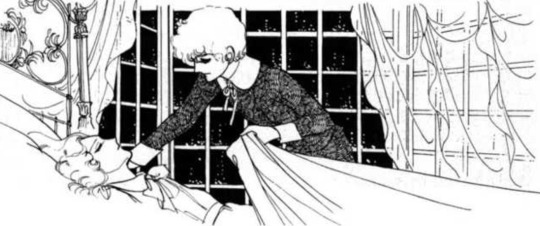
Source: The Poe Clan, Chapter 5
By: Peggy Sue Wood | @pswediting
At one point in time, I was obsessed with reading vampire novels. I couldn’t get enough of them, especially during my “Twilight phase.” Even now, I still enjoy vampire stories, but I prefer the philosophical ones that explore the nature of knowledge, reality, and existence. This preference may be why I’m drawn to Gothic literature but not to straight-out horror.
During the time I was reading all those vampire books, I discovered Moto Hagio’s The Poe Clan (1972-1976), a fascinating series of vignettes that reminded me of Anne Rice’s 1976 novel, Interview with the Vampire, despite their significant differences.
Interview with the Vampire, the first novel in The Vampire Chronicles series, tells the story of Louis de Pointe du Lac, a plantation owner in Louisiana who becomes a vampire after being turned by Lestat, another vampire. The two struggle for dominance over one another during their time together, and the novel explores themes of immortality, evil, and the meaning of humanity through this struggle, as well as the through the child vampire, Claudia, who struggles to live unchanged by time.
Despite their differences, both Interview with the Vampire and The Poe Clan share significant parallels, particularly in their characters’ internal struggles. Both works feature vampires being turned, but at very different stages of life. Lestat, an adult, turns Louis as an adult, while Edgar and his sister Marybelle are initiated into the Poe clan of vampires at a young age, forever doomed to live out eternity on the brink of adulthood.
Where Rice’s work explores immortality and its subsequent loss of humanity as being evil, creating deep conflict between mortality and immortality, Hagio’s explores immortality and its subsequent loss as one of profound grieving over being left behind by the mortal world. The Poe Clan also delves into the complex relationships between vampires and their isolation from humanity, in contrast to Interview‘s questionable coexistence, as a result of no longer being bound by time in the same way as their mortal counterparts.
Edgar feels guilt and mourns the loss of Marybelle’s and his own humanity, much like Louis feels immense guilt at Claudia’s death and turning. Edgar and Louis are figures of sorrow, abandoned by time and grieving its passing while remaining unchanged. Edgar is especially pained as he recognizes that he will forever be a child but forever growing on the inside too after having been turned as a teen, similar to Claudia.

Source: The Poe Clan, Chapter 5
For a short while, Allan and Edgar coexist in a peaceful way, but Allan is constantly reminded of Marybelle, grieving for her as his first crush, while Edgar is grieving too over her loss, his only sister and reason for being. Both characters mourn for Marybell in different ways; both characters are marked by loneliness and sorrow, seeking companionship desperately. After an incident that ends up killing a young couple, they take in the couple’s young girl named Lidelu and raise her for several years, but they never turn her. Edgar does not want to add more to the clan, and moreso than Allan, he recognizes the value of her mortality causing him to further grieve the fact that he will never experience the full range of human life like growing old and having a family.
In the end, The Poe Clan is a compelling exploration of the human condition and the search for meaning in a world where humanity marches relentlessly forward toward the future through the eyes of the immortal, adolescent vampires that were unwillingly left behind to watch, forever suspended in time. The dynamics between the vampires in The Poe Clan remind me so much of other vampire stories, particularly in the bond between Edgar and his sister Marybelle and later Allan. They are marked by grief and loneliness but take a unique approach in examining companionship during grief as both an accompaniment and issolating factor.
Truly, The Poe Clan a spectacular story to reflect upon and one I highly recommend reading if you have not done so already. (Oh, and on a final note: Despite its characters’ names being derived from Edgar Allan Poe and the setting of the Poe clan, there isn’t a direct tie storywise to the author and Hagio’s work.)
—
Written by Peggy Sue Wood and Editing using ChatGPT
#analysis#anne rice#interview with the vampire#manga#moto hagio#poe no ichizoku#the poe clan#review#reflection#vampire#vampires
13 notes
·
View notes